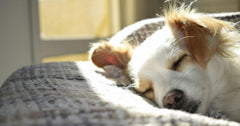
Everything a cat does often feels very purposeful. The way they walk, how they meow, and how these pets jump - it all often feels very intentional, like they're trying to be expressive at all times. In the wild, cats need to provide verbal and non-verbal cues to other animals. When they see prey, they need to hide to avoid detection so they can get it. Conversely, they'll often make their hair puff out to appear more prominent when they see a threat. These are all simple examples of cat body language.
Around the house, your cat likely won't be catching prey or seeing threats, but that doesn't mean your cat won't use body language to communicate with you. Here are five moods and their cat body language you need to know.
The Mood and Cat Body Language You'll Want the Most: Happiness

Spotting a happy cat is relatively easy. Your cat will look "at ease." If they're upright, you'll see their ears pointed forward, relaxed whiskers, and a still tail. Some cats will hold their tail up a little bit as if they're waving it to you. In this position, you'll often be able to pet your cat, and they'll contentedly close their eyes.
If your cat is lying down, they'll typically tuck their paws underneath their body. Some cats like to lie down on their side or their back. In these positions, cats will often outstretch their paws. Think about when you're happy and flop down on the bed. You probably stretch out your arms and legs too to feel relaxed and content. Your cat is the same way!
Focused

Your cat will probably get into a very focused mood now and then. Even though your feline friend might be cute and cuddly to you, they're excellent predators and will become fixated on anything they perceive as possible prey. Even if you're playing with them (e.g., shining a dot on the ground for your cat to chase), they'll become focused on that dot.
It's trivial to tell when your cat is focused. Your pet will intently stare at something, with wide-open eyes and narrowed pupils. His or her whiskers will be forward, and they'll typically angle their body toward the object of their focus. Sometimes, they'll keep their body low and look as if they're ready to pounce. This mood shouldn't cause you to worry. However, if you see your cat focused, it's usually best to stay out of its way!
The Cat Body Language Sign You'll Want the Least: Anger

If your cat growling or hissing, you know you have an angry cat on your hands. Of all the cat poses your furry friend can do, this is arguably the most recognizable. They'll be rigid. Their ears will be flat and tense, and their whiskers will be stiff and away from their face. Moreover, the cat tail language they'll display will show anger too. The tail will frequently be stiff and tense.
Your cat will just look angry. This pose is instantly recognizable as your cat is trying to show you or the object of its anger exactly how it feels.
When you see an angry cat, avoid doing anything that might upset them. Keep the situation calm and, when possible, remove any threats. Eventually, they'll go into the "relieved" state, which will look very different than their angry mode.
Relieved

If you notice your cat stretching quite a bit, looking very relaxed like they've just evaded something terrible, your cat is probably relieved. In this state, your cat's body language will be trying to undo all the stress and tension that they encountered when angry. They'll stretch a lot, relax their whiskers, clean themselves, and do very relaxing things.
If you see your cat acting like this, know that there may have been something that angered them or frightened them earlier. If possible, consider looking around your furry friend's environment to see if you can spot what the problem might have been.
Frightened

Loud noises and other sudden motions can sometimes make your cat skittish. When this happens, you'll see many of the same symptoms of anger. Your pet's ears will flatten. It will run, if possible, or crouch if they determine that running isn't an option right now. Your pet's eyes will be open wide, intently staring for threats and anything else that might come their way.
Many cat owners make a mistake when they see this mood of trying to comfort their pet. They may try to pet them, give them a treat, or talk with them. Usually, this won't do the trick. The only thing that will make your cat "normal" again is to remove whatever is frightening them! Therefore, take a look around you and see what your cat is seeing. If possible, remove the stressor. Once you do that, your pet's fear will subside, and they will likely transition into a relieved mood.
Cat Body Language Tells Owners a Lot!

Cat body language can tell their owners everything they need to know about their pets' moods. Even though we don't know what their meows mean, we can deduce our cats' mental states by learning to look at the body language. These animals are highly cognitive and they will certainly let you know how they're feeling through their body language. Seeing your pet relaxed typically means it is happy and content. Conversely, seeing your pet be stiff and tense means there is something wrong.
Cats make for the best companions so it's only right to take time and learn their language if you're going to care for one. With enough time, you'll learn your cat's poses and know how to keep your furry friend as content as possible!
Why do cats meow?
Cats meow to attempt to communicate with humans. The meow might mean that they are hungry, thirsty, or even that they want attention. Any reason that your cat might want to "tell" you something will give them a reason to start meowing at you.
How do cats communicate with each other?
With humans, cats communicate vocally the most. However, with other felines, there are different ways for these pets to communicate. Cats can communicate with other cats vocally, with their bodies, visual cues, and chemical cues.
Why do cats growl?
Cats will growl for a few different reasons. The most notable ones are when they are "annoyed, frightened, angry, or aggressive." If your pet growls at you, consider stepping back and trying to defuse the situation by giving your cat some space!
Check out our blog and follow me on LinkedIn to stay up-to-date!




